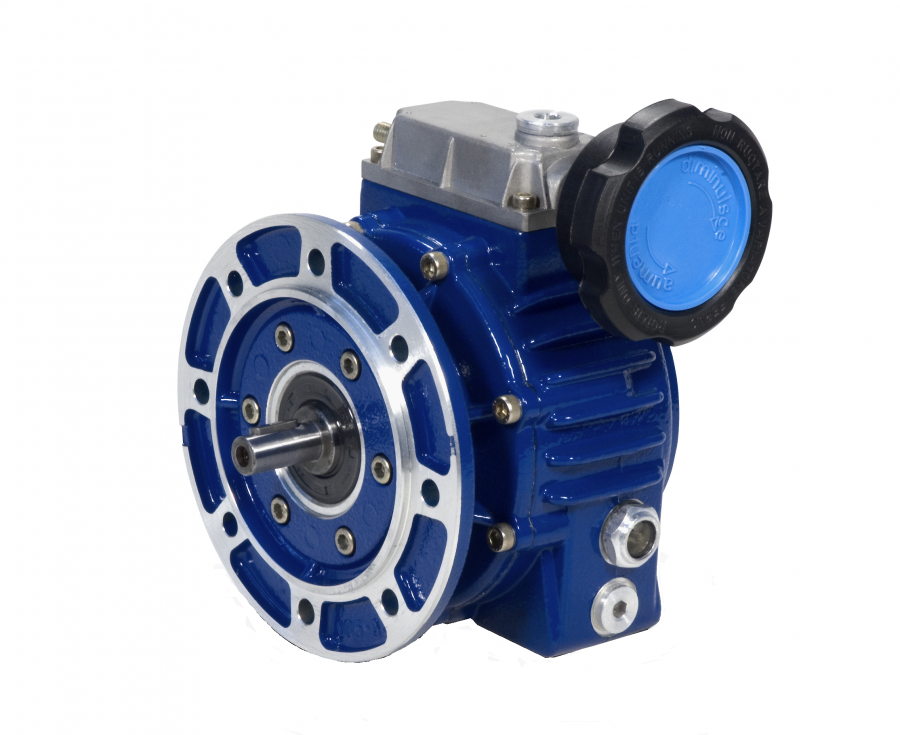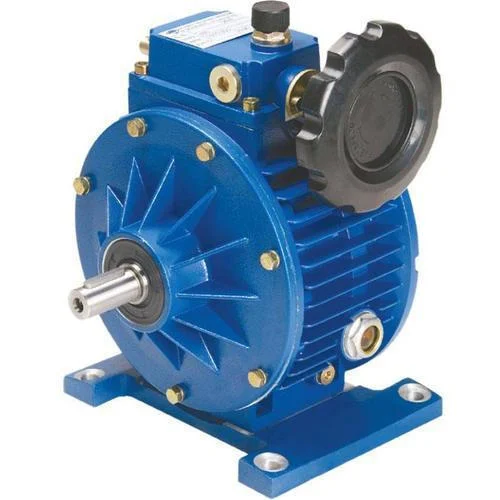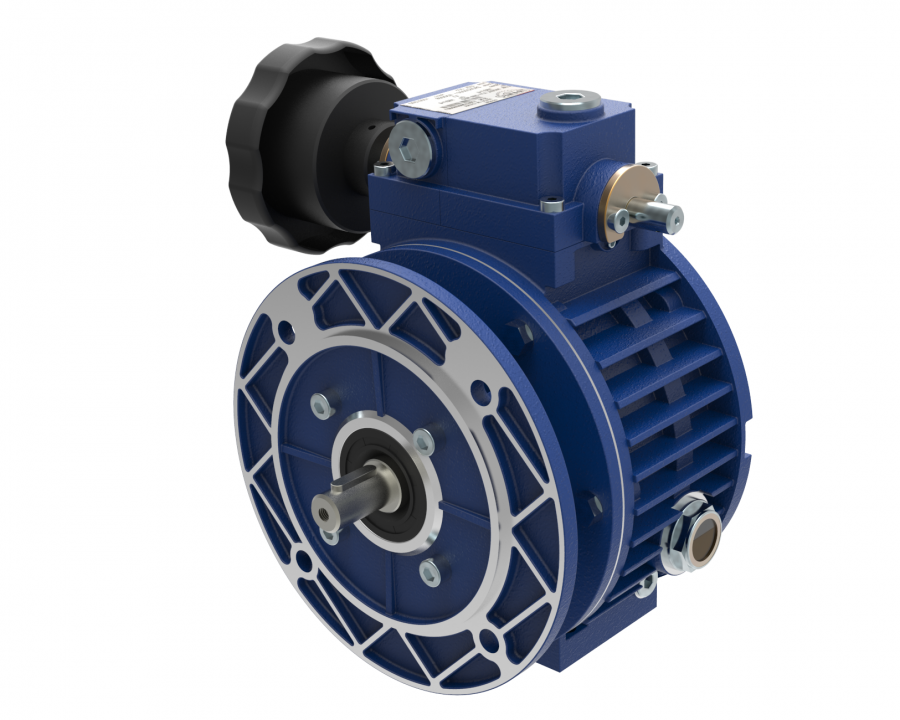Product Description
1) High precision of speed regulating for speed variator,UD gear box: up to 0.5-1 round
2) Large speed-changing range: the speed ratio ranges from 1:1.4 to 1:7 freely
3) High intensity and long serving time
4) Convenient to regulate speed
5) Continuously workable, bidirectional working direction,smooth running,
stable, and quiet
6) Fully sealed and suitable to any environment
7) Compact structure, small size
8) High quality aluminum alloy die-cast, elegant shape, light weight and non-rusting
9) Good adaptability: can be combined with all kinds of reducers to achieve low
stepless speed changing
10) Input power: 0.18-7.5kW
| Power | Model | I | n2(r/min) | M2(NM) |
| 0.18kw | UDL0.18 | 1.6-8.2 | 880-170 | 1.5~3 |
| 0.37kw | UDL0.37 | 1.4-7 | 1000-200 | 3~6 |
| 0.55kw | UDL0.55 | 1.4-7 | 1000-200 | 4~8 |
| 0.75kw | UDL0.75 | 1.4-7 | 1000-200 | 6~12 |
| 1.1kw | UD1.1 | 1.4-7 | 1000-200 | 9~18 |
| 1.5kw | UD1.5 | 1.4-7 | 1000-200 | 12~24 |
| 2.2kw | UD2.2 | 1.4-7 | 1000-200 | 18~36 |
| 3kw | UD3 | 1.4-7 | 1000-200 | 24~48 |
| 4kw | UD4 | 1.4-7 | 1000-200 | 32-64 |
| Application: | Motor, Motorcycle, Machinery |
|---|---|
| Function: | Speed Reduction |
| Output Speed: | 1000-200r/M |
| Input Speed: | 1400rpm |
| Power: | 1.1kw-7.5kw |
| Color: | Blue/Silver White |
| Customization: |
Available
| Customized Request |
|---|

Can variator gearboxes be used for both speed reduction and speed increase?
Yes, variator gearboxes are versatile and can be used for both speed reduction and speed increase applications. Their design allows for continuous and stepless adjustment of the gear ratio, enabling a wide range of speed variations in either direction. Here’s how variator gearboxes achieve speed reduction and speed increase:
Variator gearboxes utilize a mechanism called a variator, which consists of two cone-shaped pulleys connected by a belt or chain. These pulleys can move closer or farther apart, effectively changing the effective diameter of the pulley and thus the gear ratio. By adjusting the distance between the pulleys, the gear ratio can be continuously varied, resulting in different output speeds.
Speed Reduction:
When the variator gearboxes are used for speed reduction, the input speed is higher than the desired output speed. In this case, the variator mechanism adjusts the pulleys to create a smaller effective diameter on the output side. As a result, the output shaft rotates at a slower speed compared to the input shaft, achieving speed reduction. This speed reduction is useful in various applications where slower speeds are required, such as conveyors, industrial machinery, or vehicles that need lower operating speeds.
Speed Increase:
Variator gearboxes can also be used to increase the speed from the input to the output shaft. In this scenario, the input speed is lower than the desired output speed. The variator mechanism adjusts the pulleys to create a larger effective diameter on the output side. As a result, the output shaft rotates at a faster speed than the input shaft, achieving speed increase. Speed increase functionality is beneficial in applications such as certain types of machinery or vehicles that require higher operating speeds.
The ability of variator gearboxes to provide continuous and stepless adjustment of the gear ratio allows for precise control of the output speed, regardless of whether it needs to be reduced or increased. This flexibility makes variator gearboxes suitable for a wide range of applications where adjustable speed control is necessary.
It is worth noting that while variator gearboxes can provide a significant range of speed reduction and speed increase, they have limitations in terms of the maximum and minimum achievable ratios. The specific capabilities of a variator gearbox depend on its design, size, and intended application. It is important to consult the manufacturer’s specifications and guidelines to ensure that a particular variator gearbox is suitable for the desired speed reduction or speed increase requirements.

What considerations should be taken into account when choosing lubrication for variator gearboxes?
When choosing lubrication for variator gearboxes, several important considerations should be taken into account. The lubricant plays a critical role in ensuring smooth operation, reducing friction, dissipating heat, and protecting the internal components of the gearbox. Here are the key factors to consider when selecting lubrication for variator gearboxes:
Operating Conditions:
The operating conditions of the variator gearbox are a primary consideration when choosing lubrication. Factors such as temperature, load, speed, and the environment in which the gearbox operates should be evaluated. Lubricants have specific viscosity and temperature ranges in which they perform optimally. It is essential to select a lubricant that can maintain its properties and provide adequate lubrication under the anticipated operating conditions.
Viscosity:
Viscosity is a vital property of lubricants. It determines the lubricant’s resistance to flow and its ability to form a stable lubricating film between moving components. The viscosity of the lubricant should be selected based on the speed and load requirements of the variator gearbox. If the viscosity is too low, it may result in inadequate lubrication and increased wear. Conversely, if the viscosity is too high, it may create excessive friction and power losses. Manufacturers typically provide viscosity recommendations based on the gearbox’s design and intended application.
Lubricant Type:
There are various types of lubricants available for variator gearboxes, including mineral oils, synthetic oils, and greases. Each type has specific characteristics and performance properties. Mineral oils are commonly used and offer good lubrication properties at a lower cost. Synthetic oils provide enhanced performance in terms of temperature stability, oxidation resistance, and load-carrying capacity. Greases are often used in applications where the gearbox operates in a sealed environment or requires extended lubrication intervals. The type of lubricant should be selected based on the specific requirements and operating conditions of the variator gearbox.
Additives and Properties:
Lubricants may contain additives to enhance their performance and provide additional benefits. These additives can include anti-wear agents, extreme pressure additives, antioxidants, and corrosion inhibitors. Consideration should be given to the presence of these additives and their compatibility with the gearbox components. Additionally, properties such as foaming tendency, air release, and water separation characteristics should be evaluated to ensure the lubricant can effectively perform its intended functions within the variator gearbox.
Compatibility:
Compatibility between the lubricant and the materials used in the variator gearbox is crucial. Lubricants should be compatible with the gearbox’s seals, gaskets, o-rings, and other elastomeric components. Incompatible lubricants can cause swelling, degradation, or loss of functionality in these components. It is important to consult the gearbox manufacturer’s recommendations or seek expert advice to ensure the selected lubricant is compatible with all the materials used in the variator gearbox.
Maintenance and Service Intervals:
The maintenance requirements and recommended service intervals should be considered when choosing lubrication for variator gearboxes. Some lubricants may have longer service life and extended maintenance intervals, while others may require more frequent replenishment or change-outs. Evaluating the lubricant’s longevity and the gearbox’s maintenance schedule will help determine the most suitable lubrication option that meets the operational and maintenance requirements of the variator gearbox.
By considering the operating conditions, viscosity requirements, lubricant type, additives and properties, compatibility, and maintenance aspects, one can make an informed choice when selecting lubrication for variator gearboxes. Proper lubrication selection and regular maintenance will contribute to the longevity, efficiency, and reliable performance of the variator gearbox in various industrial applications.

Are there specific designs of variator gearboxes for different load conditions?
Yes, variator gearboxes can have specific designs tailored for different load conditions. The design considerations for variator gearboxes take into account the torque requirements, load conditions, and mechanical constraints of the specific application. Here are some common design variations based on load conditions:
- High Torque Applications: Some variator gearboxes are specifically designed to handle high torque applications. These gearboxes are built with robust components and materials capable of transmitting and withstanding substantial torque loads. They may incorporate features such as reinforced gears, larger bearings, and enhanced lubrication systems to ensure reliable torque transmission and durability under heavy loads. Examples of high torque variator gearboxes can be found in heavy machinery, construction equipment, and marine propulsion systems.
- Variable Load Conditions: Variator gearboxes designed for variable load conditions often incorporate adaptive control mechanisms. These gearboxes can adjust their operating parameters, such as gear ratio or hydraulic pressure, in response to changes in the load. By continuously monitoring the load conditions, they optimize the speed and torque output to match the requirements of the varying load, improving efficiency and performance. Variable load variator gearboxes are commonly used in applications where the load conditions can change dynamically, such as in industrial machinery, material handling systems, and automotive transmissions.
- Precision and Low Torque Applications: For applications that require precise speed control and low torque transmission, variator gearboxes with high accuracy and fine adjustment capabilities are employed. These gearboxes are designed to provide smooth and precise speed variations with minimal backlash or hysteresis. They may incorporate features like high-resolution position sensors, fine-tuned control algorithms, and high-precision mechanical components to achieve the desired level of accuracy. Precision variator gearboxes find applications in fields such as scientific instruments, laboratory equipment, and precision manufacturing processes.
- High-Speed Applications: Variator gearboxes designed for high-speed applications focus on minimizing rotational inertia and reducing internal friction. They are engineered to handle the challenges associated with high rotational speeds, such as centrifugal forces, heat generation, and vibration. These gearboxes often employ lightweight materials, aerodynamic designs, and advanced bearing systems to ensure smooth operation and minimize energy losses. High-speed variator gearboxes can be found in applications such as turbine generators, centrifugal compressors, and high-speed machining equipment.
- Specialized Load Conditions: In certain industries or specific applications, variator gearboxes are designed to handle specialized load conditions. These gearboxes may incorporate unique features or mechanisms tailored to the specific requirements of the application. For example, in off-road vehicles, variator gearboxes designed for rough terrains and heavy-duty applications may have reinforced casings, sealed components, and enhanced protection against dust, water, and impact. Similarly, in extreme temperature environments, variator gearboxes may be designed with specialized materials and cooling systems to ensure reliable operation under extreme heat or cold conditions.
These are just a few examples of the specific designs of variator gearboxes for different load conditions. The design of a variator gearbox is influenced by the load characteristics, performance requirements, and environmental factors of the intended application. By tailoring the design to the specific load conditions, variator gearboxes can optimize their performance, efficiency, and durability in various industrial and mechanical systems.


editor by CX 2023-10-30
